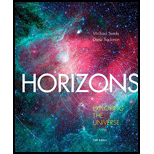
Horizons: Exploring the Universe (MindTap Course List)
14th Edition
ISBN: 9781305960961
Author: Michael A. Seeds, Dana Backman
Publisher: Cengage Learning
expand_more
expand_more
format_list_bulleted
Textbook Question
Chapter 3, Problem 8RQ
Why have most people seen a total lunar eclipse, while few have seen a total solar eclipse?
Expert Solution & Answer
Trending nowThis is a popular solution!

Chapter 3 Solutions
Horizons: Exploring the Universe (MindTap Course List)
Ch. 3 - What is the difference between the daily and...Ch. 3 - If Earth did not rotate, could you still define...Ch. 3 - What would the seasons be like if Earth were...Ch. 3 - Why are the seasons reversed in the Southern...Ch. 3 - Prob. 5RQCh. 3 - Do the phases of the Moon look the same from every...Ch. 3 - What phase would Earth be in if you were on the...Ch. 3 - Why have most people seen a total lunar eclipse,...Ch. 3 - Why isn’t there an eclipse at every new moon and...Ch. 3 - Why is the Moon red during a total lunar eclipse?
Ch. 3 - Why should the eccentricity of Earth’s orbit make...Ch. 3 - Prob. 12RQCh. 3 - Prob. 13RQCh. 3 - How Do We know? Why must a scientific argument...Ch. 3 - You are packing for a vacation on a planet...Ch. 3 - You happen to visit the Moon when some people on...Ch. 3 - Given that Earth is about 4.6 billion (4.6109)...Ch. 3 - Identify the phases of the Moon if on March 20 the...Ch. 3 - Identify the phases of the Moon if at sunset in...Ch. 3 - Prob. 4PCh. 3 - Draw a diagram showing Earth, the Moon, and...Ch. 3 - Phobos, one of the moons of Mars, is about 25 km...Ch. 3 - A total eclipse of the Sun was visible from Canada...Ch. 3 - Prob. 8PCh. 3 - The cartoon in Figure UN 3-4 shows a crescent...Ch. 3 - The photo in Figure UN 3-5 shows the annular...
Knowledge Booster
Learn more about
Need a deep-dive on the concept behind this application? Look no further. Learn more about this topic, physics and related others by exploring similar questions and additional content below.Similar questions
- What is the phase of the Moon during a total solar eclipse? During a total lunar eclipse?arrow_forwardWhen will the eclipse seasons occur during the current year? How many total of all types will occur? Which type of eclipse(s) will occur?arrow_forwardDuring 1 month, the Moon passes through how many different phases? (17.2) (a) four (b) six (c) eight (d) none of the precedingarrow_forward
- If a lunar eclipse occurred at midnight, where in the sky would you look to see it?arrow_forwardMake a list of each main phase of the Moon, describing roughly when the Moon rises and sets for each phase. During which phase can you see the Moon in the middle of the morning? In the middle of the afternoon?arrow_forwardWhy do lunar eclipses typically last much longer than solar eclipses?arrow_forward
- What are the relative positions of the Earth, the Sun, and the Moon during a lunar eclipse? During a solar eclipse?arrow_forwardIf the Moon orbited Earth from North Pole to South Pole instead of near the ecliptic, would lunar and solar eclipses still occur? Would the moon phase still have to be full or new?arrow_forwardWhat fraction of the Moon’s visible face is illuminated during first quarter phase? Why is this phase called first quarter?arrow_forward
arrow_back_ios
arrow_forward_ios
Recommended textbooks for you
 AstronomyPhysicsISBN:9781938168284Author:Andrew Fraknoi; David Morrison; Sidney C. WolffPublisher:OpenStax
AstronomyPhysicsISBN:9781938168284Author:Andrew Fraknoi; David Morrison; Sidney C. WolffPublisher:OpenStax An Introduction to Physical SciencePhysicsISBN:9781305079137Author:James Shipman, Jerry D. Wilson, Charles A. Higgins, Omar TorresPublisher:Cengage Learning
An Introduction to Physical SciencePhysicsISBN:9781305079137Author:James Shipman, Jerry D. Wilson, Charles A. Higgins, Omar TorresPublisher:Cengage Learning Foundations of Astronomy (MindTap Course List)PhysicsISBN:9781337399920Author:Michael A. Seeds, Dana BackmanPublisher:Cengage Learning
Foundations of Astronomy (MindTap Course List)PhysicsISBN:9781337399920Author:Michael A. Seeds, Dana BackmanPublisher:Cengage Learning Stars and Galaxies (MindTap Course List)PhysicsISBN:9781337399944Author:Michael A. SeedsPublisher:Cengage Learning
Stars and Galaxies (MindTap Course List)PhysicsISBN:9781337399944Author:Michael A. SeedsPublisher:Cengage Learning

Astronomy
Physics
ISBN:9781938168284
Author:Andrew Fraknoi; David Morrison; Sidney C. Wolff
Publisher:OpenStax

An Introduction to Physical Science
Physics
ISBN:9781305079137
Author:James Shipman, Jerry D. Wilson, Charles A. Higgins, Omar Torres
Publisher:Cengage Learning

Foundations of Astronomy (MindTap Course List)
Physics
ISBN:9781337399920
Author:Michael A. Seeds, Dana Backman
Publisher:Cengage Learning

Stars and Galaxies (MindTap Course List)
Physics
ISBN:9781337399944
Author:Michael A. Seeds
Publisher:Cengage Learning

Time Dilation - Einstein's Theory Of Relativity Explained!; Author: Science ABC;https://www.youtube.com/watch?v=yuD34tEpRFw;License: Standard YouTube License, CC-BY